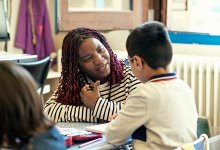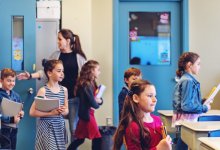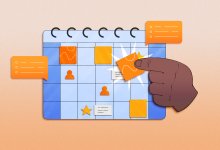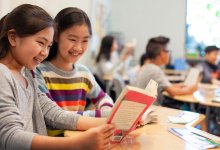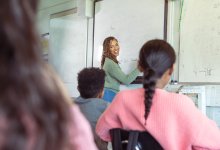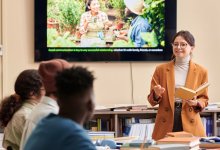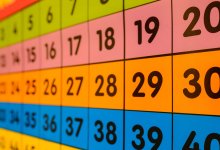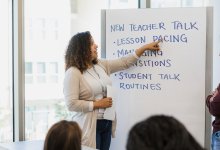- Technology Integration
5 Tech Integration Mistakes—and What to Do Differently Next Time
Classroom tech use will always involve some element of trial and error, but many pitfalls are avoidable when you know what to watch out for.357Your content has been saved!
Go to My Saved Content. - Administration & Leadership
3 Ways to Support Career-Focused Learning in High School
Linking concepts from the classroom to practical applications in career fields boosts engagement and helps students plan for their future.327Your content has been saved!
Go to My Saved Content. - Mental Health
5 Strategies to Deescalate Behavior When Students Are Dysregulated
Students may lack the skills to control their behavior when they’re upset, and these steps can help build self-regulation.543Your content has been saved!
Go to My Saved Content. - Classroom Management
60-Second Strategy: Board Splash
This quick and easy warm-up primes students to think creatively and gets them in the mindset for class.Your content has been saved!
Go to My Saved Content. - Trauma-Informed Practices
How Imaginative Play Can Help Young Children Heal From Adversity
Play can help children become fluent in the language of the nervous system, learning what their bodies and brains need in times of distress and dysregulation.1.6kYour content has been saved!
Go to My Saved Content. - Social & Emotional Learning (SEL)
Strategies to Help Students Transition Into the Week
Teachers can intentionally plan their Mondays to create classrooms that students feel drawn back into, not pressured by.706Your content has been saved!
Go to My Saved Content. - ChatGPT & Generative AI
AI Isn’t the Main Problem—It Just Shows Us What That Problem Is
Students are chasing points and grades because that’s what the education system prioritizes, but we can guide them to focus on learning. - Administration & Leadership
How Administrators Can Manage Priorities and Reclaim Their Time
Principals should spend most of their time on high-impact tasks that make a difference in teaching and learning.1kYour content has been saved!
Go to My Saved Content. - Teacher Wellness
What Teaching With a Chronic Illness Taught Me About Rest and Resilience
For teachers navigating chronic illness or pain, building a support system can keep students on track.478Your content has been saved!
Go to My Saved Content. - Classroom Management
Cultivating a Peaceful Classroom Before Winter Break
A classroom veteran shares some tips for times when students are all wound up and you still have lessons to teach.7.3kYour content has been saved!
Go to My Saved Content.
Popular
- Research
The 10 Most Significant Education Studies of 2025
We’re back with our roundup of the most insightful studies of the year, from the power of brain breaks to groundbreaking research on AI, cell phones, and handwriting in the classroom. - Student Engagement
3 Ways to Prime Students’ Brains for Achievement
Using priming language is a powerful way to set the stage for learning, and we’ve got a free downloadable word bank here to help you implement this research-backed strategy. - Student Engagement
5 Ways to Encourage Deep Mathematical Thinking
You can adapt the curriculum you have to create rich tasks that invite reasoning and build students’ problem-solving skills.28.5kYour content has been saved!
Go to My Saved Content. - Teaching Strategies
Concrete, Pictorial, Abstract: Using the CPA Method in Upper Elementary Math
Teachers can help students build deeper math understanding and confidence by introducing concepts in distinct stages. - Technology Integration
3 Simple Slide Tips That Deepen Learning—and Save Time
Whether you use Google Slides or something else, you can promote deep thinking during presentations by tweaking the slides you already have.11.9kYour content has been saved!
Go to My Saved Content.
- Administration & Leadership
Connecting School Values and Student Well-Being
Aligning your social and emotional learning curriculum with a clear set of values helps students see the relevance and importance of those lessons.1.2kYour content has been saved!
Go to My Saved Content. - Technology Integration
How to Create Effective 15-Minute SEL Activities
Teachers can use a variety of tech tools to create short social emotional learning activities that fit easily into the classroom routine.947Your content has been saved!
Go to My Saved Content. - Social & Emotional Learning (SEL)
Using Mythology to Ground Social and Emotional Learning
Teachers can leverage students’ interest in Greek mythology to explore emotions and topics like overcoming obstacles.2.2kYour content has been saved!
Go to My Saved Content. - Collaborative Learning
Manager, Facilitator, Motivator, Advocate: Setting Up Group Roles That Really Work
Designating a meaningful role for each group member helps students reach their potential both individually and collectively. - Communication Skills
How Socratic Seminars Can Empower Middle School Students
Opportunities for student-led discussions help students hone their listening, speaking, and critical thinking skills.3.7kYour content has been saved!
Go to My Saved Content.
- Student Engagement
5 Ways to Overcome the Preschool Engagement Lull
Even young students may get tired of school, and introducing movement breaks or reorganizing the classroom can help them get back on track.1.4kYour content has been saved!
Go to My Saved Content. - Student Engagement
5 Simple-to-Play Indoor Classroom Games
When the weather outside is frightful, the right activity can transform students’ pent-up energy into laughter, movement, and focus.5.3kYour content has been saved!
Go to My Saved Content. - Student Engagement
5 Ways to Encourage Deep Mathematical Thinking
You can adapt the curriculum you have to create rich tasks that invite reasoning and build students’ problem-solving skills.28.5kYour content has been saved!
Go to My Saved Content. - Teaching Strategies
How and Why to Give Optional Assignments
Providing students with the choice to complete additional work creates space for extra practice and can help build intrinsic motivation for learning. - Student Engagement
To Motivate World Language Students, Tap Into Their Goals
Teachers can use resources connected to students’ goals—such as traveling for work or pleasure—to make coursework meaningful to them.1.5kYour content has been saved!
Go to My Saved Content.
- Administration & Leadership
How to Create a Thriving Drop-In Culture
With deliberate planning and a low-stakes approach, peer drop-in initiatives offer inspiring, expert professional development without leaving the school building.1.9kYour content has been saved!
Go to My Saved Content. - New Teachers
5 Strategies to Help Build Math Fluency in K–2
Teachers can move beyond flashcards to give young students a lot of practice in developing a key math skill.4.9kYour content has been saved!
Go to My Saved Content. - Administration & Leadership
How Administrators and Veteran Educators Can Team Up to Mentor New Teachers
School leaders can support their new teachers by setting up a structured series of discussions and classroom observation sessions.4.1kYour content has been saved!
Go to My Saved Content. - Curriculum Planning
Fresh Approaches to Instructional Design
An educator with 20-plus years of experience on crafting creative and energizing lessons.7.5kYour content has been saved!
Go to My Saved Content. - New Teachers
3 Pieces of Advice for New Teachers
At the heart of these tips from a veteran is the necessity of developing flexibility in managing change in the classroom.9.5kYour content has been saved!
Go to My Saved Content.


